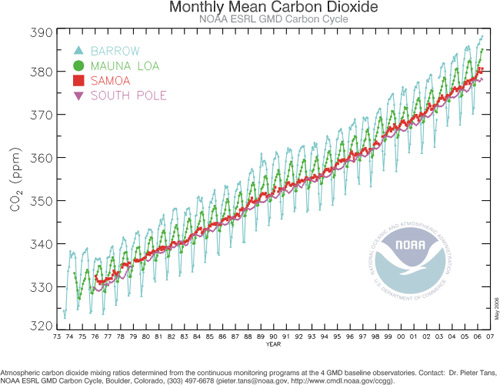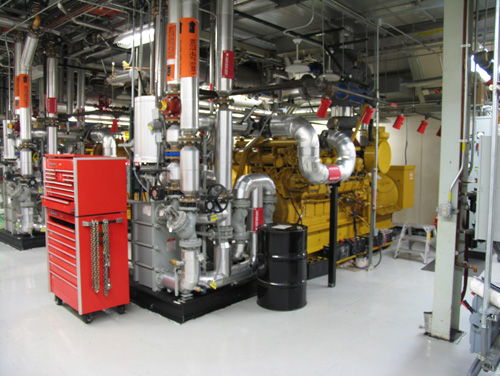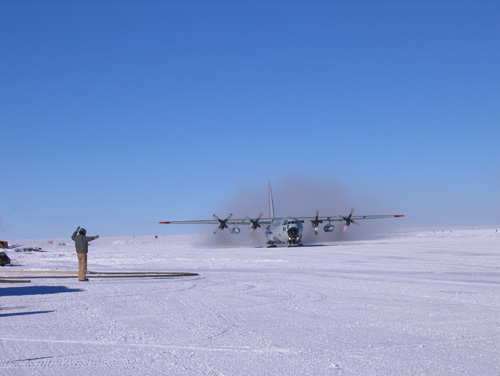Week 5 December 3 - 10 2007 South Pole and the Environment
Not long before I came down to Pole a number of people on our street block in Madison Wisconsin started to participate in an environmental program called EnAct. This program focuses on 6 different areas in which we hope to improve our environmental impact. Global climate change caused by green house gases is starting to effect everyone, and one of the largest areas of study at the South Pole is atmospheric research conducted in the Atmospheric Research Observatory (ARO - said Air-O). I though it would be interesting to describe some of the work done here and also to look at the South Pole in terms of the EnAct program.

The Atmospheric Research Observatory
The week got off to an unusual start with a Monday science lecture by Ken Mankoff. The unusual part was that science lectures are normally on Sunday nights, and that Ken was brought from McMurdo, where he is working, to give the lecture. Ken, along with about 1000 other people, has been coached by Al Gore on delivering a personalized version of Gore's famous "An Inconvenient Truth" lecture. Ken's background is in climate modeling, and he spent some time trying to explain to us how we can be skeptical of model data, and why despite the short comings of models, the results are still important and valid.
Models are an easy target for skeptics who don't even have to throw scientific rigor out the window because they don't even know what it is. In the past I have used the example of an aircraft to try and make skeptics less skeptical. I ask someone if they trust a 747 to fly. Of course they do, they trust their lives to it. But a 747 wouldn't be able to fly except for some extremely complex modeling, and if they believe we can model that, why do they think we can't model the Earth's atmosphere? I've mostly stopped using this example because most people have trouble understanding how un-aerodynamic most jet aircraft are, and how complex it is to keep the global fleet of commercial jet aircraft in the air and functioning.

Carbon Dioxide measurements by NOAA including the measurement at the South Pole.
At the end of the week we had a lecture on the Ozone hole and a related educational program by a researcher and a teacher. I found this talk very interesting as I don't think I understood just how complete the destruction of ozone is around the south polar region. While there is still some ozone very high in the atmosphere, and some low, there is a region where the Ozone normally peaks in concentration which is completely destroyed for a period of a couple of months each year as the effect of Ozone depleting chemicals take their toll. The chemical reactions, and how they are influenced by the atmosphere, particularly the polar vortex, is a bit too complex for me to go into here, but the measurements are amazing. Well before anyone knew anything about Ozone depletion during the IGY in the late 50s scientist measured the Ozone high in the atmosphere at South Pole using radio-sonds. There was no Ozone hole measured back then before the wide spread use of CFCs. It's an amazing measurement.
From the talks on climate change and ozone holes, it was clear from measurements taken at the South Pole that the human population of the Earth has significantly changed the atmosphere for the worse. This takes us back to the original theme f the EnAct program. The EnAct program has 6 topics that households address. Let's look at how the South Pole does.

The Carbon Dioxide measurement experiment operated by NOAA in the ARO building.
Energy
The South Pole is a difficult environment to find renewable energy sources in. Geothermal is tough since the bedrock surface is below 2 miles of cold ice. Even if you could tap into the bed rock, the ice sheet is moving over the rock making any connection difficult to maintain. Mawson station on the coast of Antarctica has a steady strong katabatic wind. The Australian Antarctic Program has put in wind turbines at Mawson which generates most of the station power. Unfortunately the wind at the South Pole is not strong enough or consistent enough to make wind generation feasible. The finally possibility for sustainable energy is solar. Solar doesn't work during the winter as the Sun isn't visible. During the summer the Sun is relatively low in the sky making the energy received relatively weak due to absorption in the atmosphere. The area of photovoltaic needed at South Pole would need to be extremely large to be of use and the environmental conditions make them difficult. There has been attempts to use solar thermal for heating, which has had problems because of the environmental conditions. The only example that I can think of is the solar heated out houses used during the summer at remote work locations. These are black buildings with panels that enhance warmed air circulation in the building. They keep the buildings around freezing, which is a significant improvement over the outside temperatures.

Solar heated out house.
Since renewable energy isn't an option, conservation and energy generation efficiency are the only areas which there is any control over. During November the average power consumption of the South Pole was a bit over 600kW. I don't know for certain but maybe up to 200kW is used directly for science projects. With a population of about 250 people that that gives an average of about 1.5kW per person. Is that a lot? Considering the average temperature of the South Pole is below -50 degrees maybe this seems reasonable. Waste heat from the power generation process is used for building heating and water generation. The walls of the new station are foam panels about 1 foot thick, and then there is a large air gap for further insulation. Energy conservation is stressed on station. Even still the station uses more energy than expected during the design process and attempts are being made to improve the energy efficiency.
The power generation process is standard diesel generators. The station used about 17000 gallons of diesel a week during November. This is not the most efficient process known. There has been talk of more efficient natural gas power generation. However there are 2 reasons this will not happen over night. Reliability of the generators is extremely important. An outage of hours is very long at the South Pole and smaller buildings will noticeably chill in this time. Presently the standard diesel generator system is consider more reliable. The other is fuel transportation and storage. Diesel fuel is much safer to transport and store, especially compared to natural gas. Also the aircraft that fly to Pole use the same fuel as the generators (and many vehicles at Pole). This gives great flexibility which certainly results in efficiency.

One of the 3 main generators in the South Pole Power Plant.

Exhaust from the Power Plant. It looks worse than it is as the very cold dry air causes the water in the exhaust to condense out.
Food
I haven't read the EnAct section on food yet, but I assume it will be something along the lines of my own beliefs with regards to food, that we alls should eat healthy, preferably organic, locally grown using sustainable agricultural methods, and tastes good. At home we grow and make as much as of our food as possible, such as yogurt, bread, and preserves. A concept I'm fond is the 100 Mile Diet.
On their web site there is a "direct challenge to scientists in Antarctica and astronauts in the International Space Station" to eat locally. In the 100 Mile Diet everything has to be grown locally, which might include the feed for the chickens that lay the local eggs. Right away the South Pole is in trouble as even if you wanted to grow locally all nutrients and fuel for heat would have to be brought in.
In general the food at Pole is food that survives freezing, and is often dry. While the cooks go to great lengths to prepare food that is interesting and yet meet the personal preferences of as many people as possible, it can hardly meet the normal standards we try and live by at home. There is one significant effort to provide fresh high quality food. There is a hydroponics unit at Pole, known as "the growth chamber", where fresh veggies, mostly salad, are produced. When in full production a decent salad for the station can be expected at least once a week. This is a great addition to the Pole diet.

Hydroponics unit, also known as "The Growth Chamber"
Solid Waste
I will give it to the waste department, they are fanatical about sorting waste into as many recyclable categories as possible. There are rows of large tri-wall cardboard containers for every type of waste. So the people that dispose of the waste seem to do a great job. Where we fall down is on reducing packing and thus the waste in the first place. This is difficult. I have some direct control over this for the computing equipment we send down. We seem to produce an amazing amount of waste. I do try and reduce the packaging we send south. But in general our vendors send stuff over packaged. The number of plastic bags we get are staggering - plastic bags in plastic bags. I would estimate we have got thousands of copies of the HP warranty book which is half an inch thick, and I've never looked at it.

Waste management at South Pole. Each container is a different type of waste.
I don't think EnAct would consider human waste as solid waste, but I'm going to cover it here. In McMurdo I believe there is a sophisticated waste treatment plant which potentially could separate out solids and discharge very clean water to the sea. However at present this solid waste is discharged into McMurdo Sound. Introducing this level of nutrients doesn't feel like it can be good for the natural state of this ecosystem. At Pole the solid waste is used to back fill water wells that have become too large. It's a little disturbing when you see how close the present Rod Well is to the current sewerage outfall. I'll hold judgment on this one until someone tells me if a study has be done on the energy cost of transporting this waste back compared to the environmental cost of doing what is done now.
Transportation
Without a doubt South Pole looses on transportation. The Hercules aircraft we fly everything to Pole in are incredibly dirty aircraft. Watching one land you can see the brown smudge in the sky behind it. Then at Pole we run machinery and vehicles continually to keep them warm. Starting them often involves long periods of waiting to warm them up and for lubricants to become effective. Batteries are extremely prone to freezing, so electric vehicles seem out of the question. Maybe there aren't many choices and maybe transportation is essential to doing the work at the South Pole. But I feel no effort has been made to address this in the slightest. There is a F350 truck that drives around Pole which is without a doubt an extravagant status symbol which seals it for me.

LC-130 arriving at South Pole.
Water Quality
Antarctica contains most of the worlds fresh water. The catch is that is in solid form and at the South Pole it is difficult to access. The water at Pole is produced in what is called the Rod Well (short for the original designed, Rodriguez). A hole is drilled deep into the solid ice below the porous surface ice snow, known as the firn layer. Once a hole a couple hundred feet deep is made hot water is pumped into it and re-circulated. As ice melts a bulb of water forms which becomes a water reservoir. This is continually maintained and enlarged to become the South Pole Rod Well.
The water in the Rod Well is pure melted snow which has had no contact with minerals. At first you might consider this high quality water. However the lack of minerals makes the water corrosive and unhealthy to drink. Drinking this water untreated would result in minerals being leached from the body and would be very bad for you. Thus the water is treated by adding minerals by among other things running the water over a limestone slab and adding some chlorine. The chlorine seems unusual except you have to consider there is storage tanks and a massive plumbing network in which bugs can grow and contaminated the water. Thus the chlorine is added. In general the water quality would have to be considered very good at South Pole.
Water Conservation
While waste heat from the generators is used to produce water, there is only so much waste heat. At present there is not an excess of waste heat, and there is unlikely to be. As the station becomes more efficient electrically there is less waste heat and fuel has to be burnt to produce water. So in some ways water is fuel at the South Pole. Considering the difficulty of getting fuel to South Pole, and the difficulty in making the water, water conservation is taken very seriously. The rules are 2 2 minute showers and one load of washing each week. These rules certainly focus attention on water conservation in other areas of water use. The average station use per week during November was 32000 gallons, which is about 18 gallons per person per day. This compares fairly well to the average consumption of about 80 gallons per person per day in Madison Wisconsin.
It is hard to imagine improving the water conservation significantly at South Pole. However at McMurdo station on the coast I bet there is significant room for improvement. McMurdo has a sea water desalination pant, and fuel is relatively easy to deliver to McMurdo by ship. I'm always shocked by the cavalier attitude of McMurdo residents to water use. After arriving from Pole these people seem wasteful in the extreme.
So how does the South Pole measure up. It does seem that significant efforts are being made towards conservation and efficiency. However large amounts of resources, especially fossil fuels are needed to operate the Pole. In general I personally feel my presence at Pole is contributing significantly towards global warming and any positive results from research such as the climate research done do not negate the cost. Is advancing science with projects such as IceCube worth the cost? It's something I'm not completely comfortable with and I will continue my low key campaign towards getting the state to pay for renewable energy for the non-Pole Data Centers I manage (100kW). Without a doubt there is a significant environmental cost to running the South Pole, and the potential for making it carbon neutral seem small, but with some efforts along the lines of the NSF mandating the use of renewable energy when ever possible for projects it sponsors I would be more comfortable with the environmental cost of the research undertaken.
To be continued.

